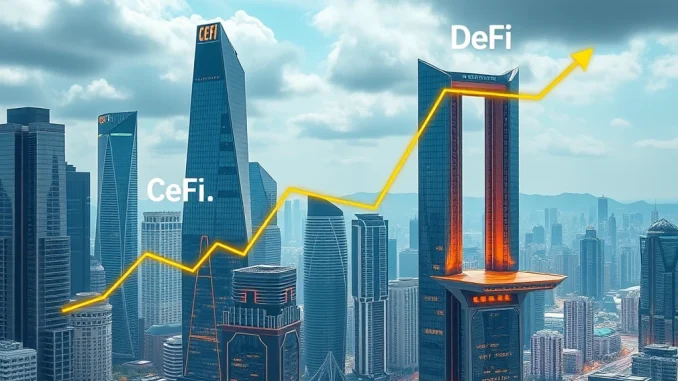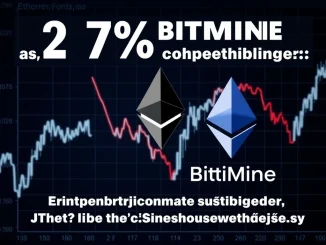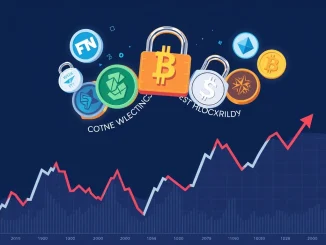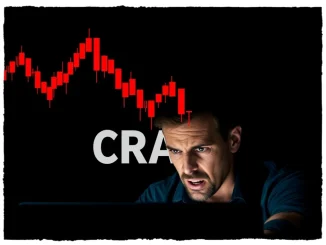
The crypto lending landscape has witnessed a dramatic shift. While the overall market has contracted significantly from its previous highs, a powerful force is emerging from the decentralized finance (DeFi) sector. Are you ready to understand how DeFi loans are defying market trends and what this means for the future of crypto finance?
What’s Happening in the Crypto Lending Market?
Recent data reveals a fascinating dichotomy within the crypto lending market. A report from Galaxy Digital, highlighted by Cointelegraph, indicates a substantial contraction in the overall market size. Let’s break down the key figures:
- Peak Market Size (2021): $64.4 billion
- Current Market Size (Q4 2024): $36.5 billion
- Market Contraction: 43% decrease from the peak
This data paints a picture of a market that has cooled down considerably from the exuberant highs of 2021. The decline suggests a recalibration, potentially influenced by various factors like market corrections, regulatory uncertainties, and shifts in investor sentiment. But this is only half the story.
The DeFi Revolution: DeFi Loans Surge Against the Tide
While centralized finance (CeFi) lending appears to be facing headwinds, the decentralized finance (DeFi) sector is showcasing remarkable resilience and growth, particularly in the realm of DeFi loans. Incredible growth is being observed in open borrows within DeFi. Let’s look at the numbers:
- DeFi Open Borrows Growth: 959% surge from 2022 lows
- Current DeFi Open Borrows: $19.1 billion
This near ten-fold increase in DeFi loans signifies a powerful trend. It indicates a growing preference for decentralized lending platforms and a potential shift in market dynamics. But why are we seeing such a stark contrast between CeFi and DeFi lending?
CeFi vs. DeFi Lending: Understanding the Divide
To truly grasp the current state of the lending market rebound in DeFi, it’s crucial to understand the fundamental differences between CeFi and DeFi lending:
| Feature | Centralized Finance (CeFi) Lending | Decentralized Finance (DeFi) Lending |
|---|---|---|
| Control | Centralized entities control platforms and assets. | Decentralized protocols, users retain control of assets. |
| Transparency | Less transparent, operations are often opaque. | Highly transparent, transactions and protocols are typically open-source and auditable on the blockchain. |
| Custody | Users typically relinquish custody of their assets to the platform. | Users retain custody of their assets in their own wallets. |
| Regulation | Subject to traditional financial regulations. | Regulation is still evolving, operates in a less regulated space. |
| Accessibility | Can be geographically restricted and require KYC/AML. | Generally more accessible globally, often permissionless. |
The contrasting characteristics highlight why DeFi loans are gaining traction, especially in a market seeking transparency, self-custody, and potentially higher yields. The 959% surge suggests that users are increasingly valuing the benefits of DeFi lending.
Why are DeFi Loans Experiencing Such Explosive Growth?
Several factors could be contributing to the impressive resurgence of DeFi loans:
- Increased Trust in DeFi Protocols: As DeFi protocols mature and are rigorously tested, user confidence grows.
- Desire for Self-Custody: Recent events in the CeFi space have emphasized the risks of centralized custody, driving users towards self-custodial DeFi solutions.
- Attractive Yields: DeFi lending platforms often offer competitive yields compared to traditional finance and even some CeFi platforms.
- Innovation in DeFi Products: Continuous innovation in DeFi is creating more sophisticated and user-friendly lending and borrowing options.
- Global Accessibility: DeFi’s permissionless nature allows users worldwide to participate in lending and borrowing, expanding the market reach.
Challenges and Risks in the DeFi Lending Market
While the growth of DeFi loans is exciting, it’s important to acknowledge the inherent challenges and risks:
- Smart Contract Risks: DeFi protocols rely on smart contracts, which can be vulnerable to bugs or exploits.
- Volatility: The cryptocurrency market is inherently volatile, which can impact the value of collateral and loan positions.
- Regulatory Uncertainty: The regulatory landscape for DeFi is still evolving, and future regulations could impact the market.
- Complexity: Navigating DeFi protocols can be complex for new users, requiring a certain level of technical understanding.
- Liquidation Risks: In volatile markets, borrowers face the risk of liquidation if their collateral value drops below a certain threshold.
Actionable Insights: Navigating the Evolving Lending Landscape
For those interested in the crypto loans and lending market, here are some actionable insights:
- Due Diligence is Key: Whether exploring CeFi or DeFi, thorough research is essential. Understand the platforms, protocols, and associated risks.
- Start Small in DeFi: If new to DeFi lending, begin with small amounts to familiarize yourself with the processes and risks involved.
- Diversify Your Lending Portfolio: Consider diversifying across different platforms and types of loans to mitigate risk.
- Stay Informed: The crypto lending market is dynamic. Keep up-to-date with market trends, protocol developments, and regulatory news.
- Understand Smart Contract Audits: When using DeFi platforms, check for and understand the results of smart contract audits.
Conclusion: The Future of Crypto Lending – DeFi Leading the Charge?
The crypto lending market is undergoing a significant transformation. While the overall market size has contracted, the explosive growth of DeFi loans signals a potential paradigm shift. The 959% rebound in DeFi open borrows is not just a number; it’s a powerful indicator of evolving user preferences and the increasing prominence of decentralized finance. As the market matures, the interplay between CeFi and DeFi will likely shape the future of crypto lending, with DeFi potentially leading the charge towards a more transparent, accessible, and user-centric financial ecosystem. The surge in DeFi is a compelling narrative, and it will be fascinating to watch how this trend unfolds in the coming years.



